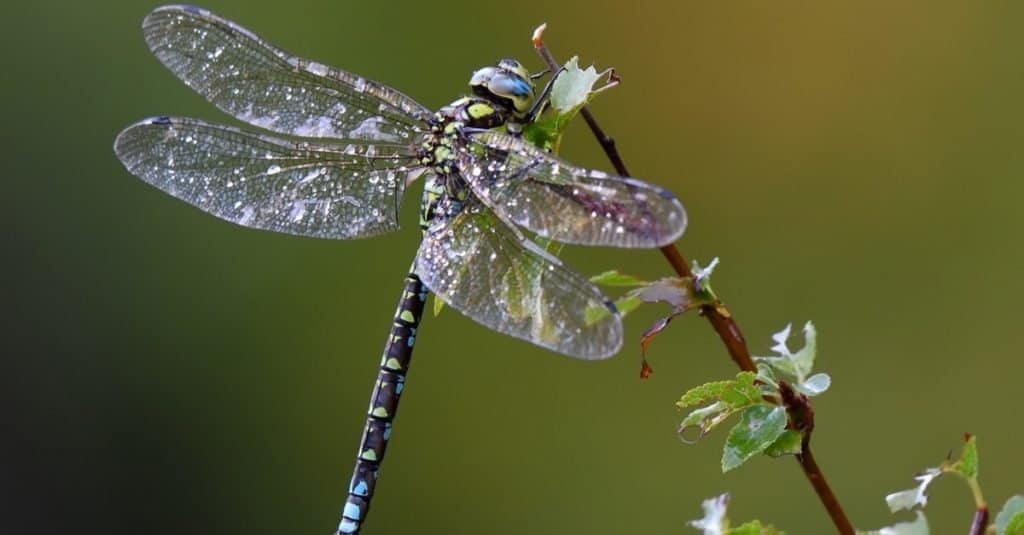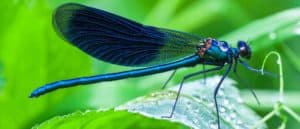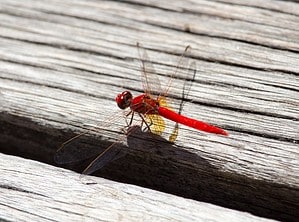These expert fliers move in a dazzling display, enchanting you as they pass by. They’re incredibly nimble in the air, which makes them unbelievably efficient hunters. But after working for their food all day, where do dragonflies go at night to sleep? Let’s find out!
Dragonfly Overview
Dragonflies (scientific name: Anisoptera) are flying insects that belong to the order Odonata. They have a unique appearance that distinguishes them from other flying insects, specifically their long and transparent wings.
They have slender bodies and large eyes and boast a range of colors depending on the type. They typically incorporate different shades of colors ranging from green and yellow to blue and red. Their flight style is quick and agile, appearing like an acrobatic performance.
These are carnivorous insects that feast on other smaller insects like gnats and flies. With their impressive mid-flight movements, they make exceptional hunters, able to capture other flying insects in the middle of their own flights.

The flame skimmer is a popular
dragonfly
native to western North America.
©Sarah Argo/Shutterstock.com
As adults, dragonflies have relatively short lifespans, sometimes stretching only a few weeks and other times, stretching over the span of a couple of months. It depends on the species. These insects are unique in the way they transform. They first start as aquatic larvae in freshwater. In the water, the nymphs are equipped with gills so they can extract oxygen from the water that surrounds them.
As they develop, they go through a metamorphosis to develop into the winged dragonflies you witness in meadows and near gardens. To emerge as the strikingly beautiful, winged creatures you recognize, they must shed their exoskeleton and depart from their initial aquatic home.
Dragonfly Behavior
Mating and Reproduction
How each dragonfly courts another depends on the species but typically, they involve mesmerizing displays mid-flight. When a female is won over by a male’s elaborate aerial dance, they mate and the female lays her eggs. The females do this in one of two ways: either by letting their eggs drop into water or by picking out a submerged plant and setting their eggs down there.
Communication
In courtship, it’s body language that helps males communicate with females. But they also use their bodies when communicating territorial messages. Aside from the way they fly, they also employ varying visual cues to communicate their intentions.
Hunting and Feeding
Dragonflies are known for their exceptional hunting abilities. With their in-flight agility, they can capture their preferred snacks, which include mosquitoes and even tiny butterflies. They have impressive eyesight which only aids their hunting prowess. When they’re still in the larvae stage, they rely on themselves as well. Even at this young stage, they are already hunting, and preying on aquatic insects.

Dragonflies are known for their exceptional hunting abilities.
©aaltair/Shutterstock.com
Resting and Sunning
Dragonflies are most active when they’re hunting and when looking to mate. Otherwise, they take time to conserve their energy and pick different perches to rest their bodies. They remain mostly still while resting as they soak up the warmth of the sun.
Migration
Some dragonfly species, like the globe skimmer dragonfly (also known as the wandering glider), migrate unbelievably long distances alongside one another in search of areas where the food is bountiful and where they can breed comfortably.
Where Do Dragonflies Go at Night to Sleep?
Dragonflies don’t exactly pull the covers down to slip into bed just before turning off the lamp on the nightstand. Their brains do not process sleep cycles and they do not even have eyelids to close! Nevertheless, they do require periods of recharging.
This is a form of rest they engage in when the sun has gone down or when the weather is too rough for them to be active during the day. When deciding on a place to settle into for some rest, dragonflies seek out safety both from predators and adverse weather. Some of the areas they may seek out at night include manmade structures, trees, shrubs, rocks, and vegetation — especially around bodies of water.
Manmade Structures
If dragonflies deem a fence cozy enough for a resting period, they may just perch there. This is especially the case if the fence or other structure is positioned near a body of water like a pond or a stream.
Trees and Shrubs
Shrubs and tree branches near water are also suitable for dragonflies when they’re seeking a place to rest. They might perch on a specific branch more than once if they deem it favorable.
Rocks and Vegetation
Right around the edges of a pond or a stream, there are rocks and vegetation where dragonflies can settle in and rest. They may choose vegetation for a vantage point or rocks so they can absorb some heat during the day while they recover their energy.
The photo featured at the top of this post is © AgriTech/Shutterstock.com
Thank you for reading! Have some feedback for us? Contact the AZ Animals editorial team.






